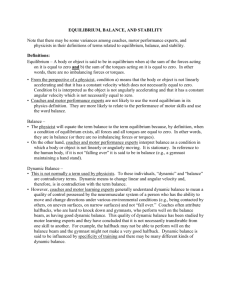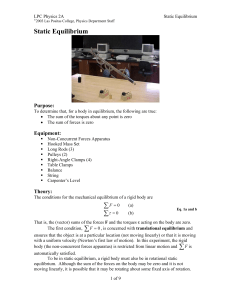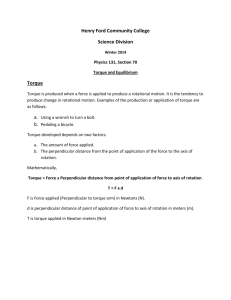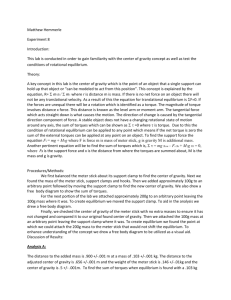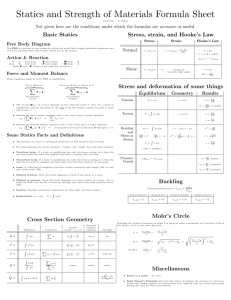Static Equilibrium
advertisement
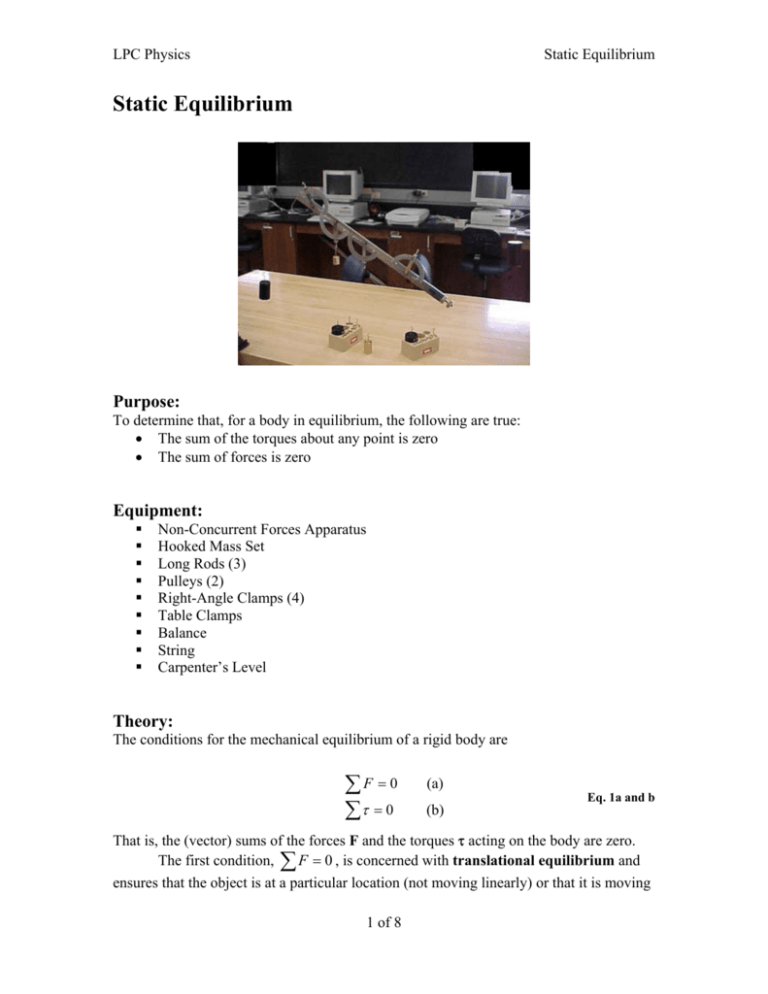
LPC Physics Static Equilibrium Static Equilibrium Purpose: To determine that, for a body in equilibrium, the following are true: • The sum of the torques about any point is zero • The sum of forces is zero Equipment: Non-Concurrent Forces Apparatus Hooked Mass Set Long Rods (3) Pulleys (2) Right-Angle Clamps (4) Table Clamps Balance String Carpenter’s Level Theory: The conditions for the mechanical equilibrium of a rigid body are ∑F = 0 ∑τ = 0 (a) Eq. 1a and b (b) That is, the (vector) sums of the forces F and the torques τ acting on the body are zero. The first condition, ∑ F = 0 , is concerned with translational equilibrium and ensures that the object is at a particular location (not moving linearly) or that it is moving 1 of 8 LPC Physics Static Equilibrium with a uniform velocity (Newton’s first law of motion). In this experiment, the rigid body (the non-concurrent forces apparatus) is restricted from linear motion and ∑ F is automatically satisfied. To be in static equilibrium, a rigid body must also be in rotational static equilibrium. Although the sum of the forces on the body may be zero and it is not moving linearly, it is possible that it may be rotating about some fixed axis of rotation. However, if the sum of the torques is zero, ∑τ = 0 , the object is in rotational equilibrium, and either it dies not rotate (static case) or it rotates with a uniform angular velocity. (Forces produce linear motion and torques produce rotational motion.) A torque, or moment of force, results from the application of a force acting at a distance from an axis of rotation. The magnitude of the torque is equal to the product of the force’s magnitude and the perpendicular distance from the axis of rotation to the force’s line of action, or τ = Fd (Figure 1). The distance d is called the lever arm or the moment arm of the force. Force Line of action Axis of rotation (perpendicular to plane of paper) d F Figure 1 The magnitude of the torque is equal to the product of F and the perpendicular d from the axis of rotation to the force’s line of action τ = Fd. Relative to an axis of rotation, a rigid body can rotate in only two directions: clockwise and counterclockwise. It is therefore customary to refer to clockwise torques and counterclockwise torques, that is, torques that may produce clockwise rotations and torques that may produce counterclockwise rotations. For example, in Figure 2, F1 and F2 produce counterclockwise torques and F3 and F4 produce clockwise torques, but no rotation would take place if the system were in rotational equilibrium. d4 d1 d2 d3 50 cm m1 m2 F1 = m1g F2 = m2g m3 F3 = m3g m4 F4 = m4g Figure 2 An example of torque in different directions. F1 and F1 give rise to counterclockwise torques and F3 and F4 to clockwise torques. The condition for rotational equilibrium is 2 of 8 LPC Physics Static Equilibrium ∑τ = ∑τ cc + ∑τ cw = 0 Eq. 2 where τcc and τcw are counterclockwise and clockwise torques, respectively. Designating the directions arbitrarily by plus and minus signs, Eq. 2 can be written ∑τ cc ∑τ − ∑τ cw = 0 or cc = ∑τ cw Eq. 3 sum of counterclockwise torques = sum of clockwise torques For example, for the rod in Figure 2, we have Clockwise Counterclockwise τ1 +τ 2 = τ 3 +τ 4 or F1 d 1 + F2 d 2 = F3 d 3 + F4 d 4 The forces are due to weights suspended from the rod. Then, with F = mg, m1 gd 1 + m2 gd 2 = m3 gd 3 + m4 gd 4 m1 d1 + m2 d 2 = m3 d 3 + m4 d 4 Eq. 4 Center of Gravity and Center of Mass The gravitational torques due to “individual” mass particles of a rigid body define what is known as the body’s center of gravity. The center of gravity is the point of the body about which the sum of the gravitational torques around an axis through this point is equal to zero. For example, consider the rod shown in Figure 3. If the rod is visualized as being made up of individual mass particles and the point of support is selected such that ∑τ = 0 , then ∑τ or cc = ∑τ cw ∑ (m g )d = ∑ (m g )d i cc i i i cw and (m1 d1 + m2 d 2 + m3 d 3 + L) cc = (m1 d1 + m2 d 2 + m3 d 3 + L) cw With the rod in rotational equilibrium, it may be supported by a force equal to its weight, where the support force is directed through the center of gravity. Hence, it is as though all of the object’s weight (Mg) is concentrated at the center of gravity. That is, if you were blindfolded and supported an object at its center of gravity on your finger, weightwise you would not be able to tell if it were perhaps a rod or a block of equal mass. If an object’s weight were concentrated at its center of gravity, so would be its mass, and we often refer to an object’s center of mass instead of center of gravity. These 3 of 8 LPC Physics Static Equilibrium points are the same as long as the acceleration due to gravity, g, is constant (uniform gravitational field). Notice how g can be factored and divided out of the previous “weight” equations, leaving “mass” equations. Also, it should be evident that for a symmetric object with a uniform mass distribution, the center of gravity is located at the center of symmetry. For example, if a rod has a uniform mass distribution, its center of gravity is located at the center of the rod’s length. Why? Center of gravity m1g m4g m4g m1g Mg Figure 3 A rod can be considered as being made up of individual masses in rotational equilibrium when the vertical support force is directed through the center of gravity Experiment: x1 = 0 x2 θ1 xcg mg m4 m1 c.g θ3 m2 adj. m3 x3 x4 Figure 4 1. Determine the mass of the non-concurrent force apparatus. 2. Suspend the apparatus horizontally by strings attached to weights, as shown in the sketch. Weights should not be attached symmetrically. 4 of 8 LPC Physics Static Equilibrium 3. Adjust weights and the center of gravity adjustment to obtain equilibrium. 4. Measure the distances and angles necessary to determine the torques. Record uncertainties for all measurements. 5. Remove m2 and m4 and adjust m1 and m3until the apparatus is again horizontal. 6. DO NOT change the center of gravity adjustment. Measure θ3 and calculate the center of gravity. Analysis: 1. Carefully make a large sketch of the apparatus indicating the forces acting on the apparatus and their corresponding angles. 2. Assuming the pulleys are frictionless, write Newton's 2nd Law for torques and forces as applied to the equilibrium of the apparatus. 3. Which of the torques are positive? Calculate each positive torque and its uncertainty. Add the positive torques to find the total positive torque. 4. Calculate the error in the total positive torque. 5. Repeat Step 3 in the analysis for each negative torque. Calculate the total negative torque and its uncertainty. 6. Does the absolute value of the total negative torque equal the total positive torque within the uncertainty? Why or why not? Note: How would we calculate the uncertainty in sinθ when the uncertainty in θ , δθ, is known? One way is to calculate: sin(θ + δθ) and sin(θ - δθ) i.e., δ(Sinθ) = 7. Sin(θ + δθ) - Sin(θ - δθ) 2 Calculate % difference between positive and negative torques as well as the % uncertainty in your measurements. Results: Write at least one paragraph describing the following: • what you expected to learn about the lab (i.e. what was the reason for conducting the experiment?) 5 of 8 LPC Physics • • • Static Equilibrium your results, and what you learned from them Think of at least one other experiment might you perform to verify these results Think of at least one new question or problem that could be answered with the physics you have learned in this laboratory, or be extrapolated from the ideas in this laboratory. 1 1 The theory section of this lab was shamelessly borrowed from: Jerry D. Wilson. Physics Laboratory Experiments, 2nd Edition. Lexington MA: D.C. Heath and Company, 1986. Experiment 13. 6 of 8 LPC Physics Static Equilibrium Clean-Up: Before you can leave the classroom, you must clean up your equipment, and have your instructor sign below. How you divide clean-up duties between lab members is up to you. Clean-up involves: • Completely dismantling the experimental setup • Removing tape from anything you put tape on • Drying-off any wet equipment • Putting away equipment in proper boxes (if applicable) • Returning equipment to proper cabinets, or to the cart at the front of the room • Throwing away pieces of string, paper, and other detritus (i.e. your water bottles) • Shutting down the computer • Anything else that needs to be done to return the room to its pristine, pre lab form. I certify that the equipment used by ________________________ has been cleaned up. (student’s name) ______________________________ , _______________. (instructor’s name) (date) STATIC EQUILIBRIUM DATA TABLES AND ANALYSIS 7 of 8 LPC Physics m1 m2 Static Equilibrium m3 Experimental Equilibrium Data x1 θ1 θ2 θ3 θ4 m4 x2 x3 x4 xcg Net Torque Positive Torque (τ+ ) Negative Torque (τ− ) % Difference τ + −τ − (τ + + τ − ) 2 Error Analysis % Uncertainty δθ1 δθ2 δθ3 δθ4 δx1 δx2 δx3 δx4 8 of 8 δxcg δτ+ δτ− ⎛⎜ δτ + + δτ − ⎞⎟ × 100 ⎜τ τ − ⎟⎠ ⎝ +


